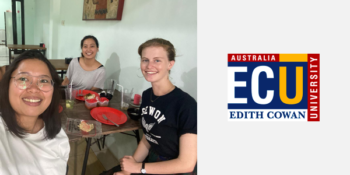Anastasia Beasley was a participant in the 2020 Creative Arts and Design Professional Practicum from Edith Cowan University. Anastasia is studying a Bachelor of Arts (Arts Management). She received a $3,000 New Colombo Plan Mobility Grant to support her participation in this program.
Q: Why did you decide to undertake ACICIS’ Creative Arts & Design Professional Practicum?
I wanted to participate in the ACICIS practicum because I didn’t know anything about Indonesia’s history or culture, and I was excited to learn more about that by working in an arts organisation. I knew that it was a very unique opportunity and it’s unlikely I would have any friends in the Indonesian arts community if I hadn’t done the program.
Q: Did you receive a New Colombo Plan Mobility Grant? If so, how did this contribute to your experience in Indonesia?
I did receive a mobility grant, which covered most of my practicum fee so I just had to budget for airfares and living costs.
Q: How will the Creative Arts & Design Professional Practicum benefit or influence your future career?
The Professional Practicum gave me some insight into how it’s possible for galleries, exhibitions, music festivals and theatres to exist without the kind of support (from mining companies or the government) that they typically receive in Australia. I was amazed at how generous artists were with helping each other out, and making sure their work (and that of their friends) got to be completed and displayed. They have a different attitude towards collaborating and making art, and while it’s definitely not for everyone, I’d love to bring some of what I’ve learned to the arts community in Australia.
Q: Which organisation did you intern with? What were your roles and responsibilities?
I interned with Ace House Collective, which is an artist collective in Jogjakarta that functions as a youth arts laboratory. My main role during the practicum was to prepare project proposals for Ace House’s activities that they could use on their website, in grant applications, or in applications to galleries.
Q: How is the work culture of your host organisation different to work experience you have had in Australia?
The thing that surprised me most about the host organisation was the level of trust they had in me, compared to the level of trust I’d expect in Australia. Even though I was much younger than them and coming in as an intern, they still wanted my opinions and advice about funding, grant writing, and running artist residencies. As an artist collective, Ace House was quite laid-back, friendly, and unstructured, so I had a very flexible schedule and almost never worked with other people without eating with them.
Q: Would you like to return to work in Indonesia again in the future?
Absolutely. I loved staying in Yogyakarta but there’s so much more of Indonesia I haven’t seen and I’m curious to see how different all the cities are from each other.
Q: What do you like to do in your spare time in Indonesia?
I’m always looking to try new food, so it felt like eating was my main activity in Indonesia. I also liked checking out the different art spaces, walking around and looking at the street art, and chatting to the artists who would come in and out of Ace House.
Q: Favourite place to eat and favourite Indonesian food?
I actually love eating on a mat on the side of the road or at an angkringan, because you get to be in a public space but feel comfortable and safe, and you can sit down with your food and hot tea and watch the world go by. One place I particularly liked was a gudeg stand that opened up at night in front of a shoe shop at the end of my street.
Q: Favourite Indonesian word/phrase?
Ngak apa apa – kind of like “no worries”
Q. What places in Indonesia have you visited during your practicum so far?
Jogjakarta, Bandung, Gunung Lawu and Madiun.


